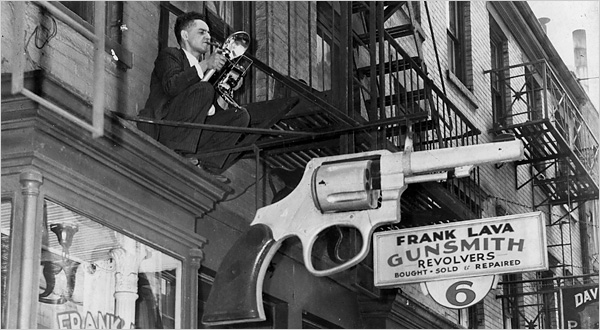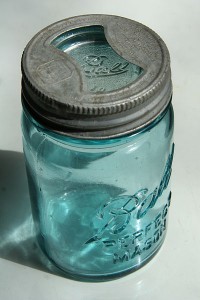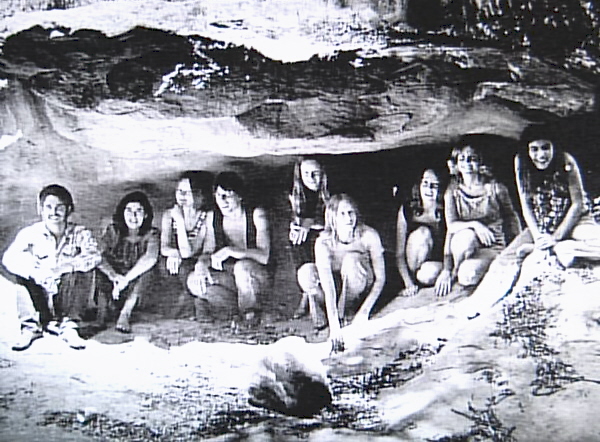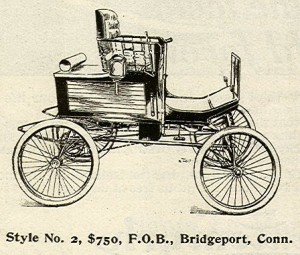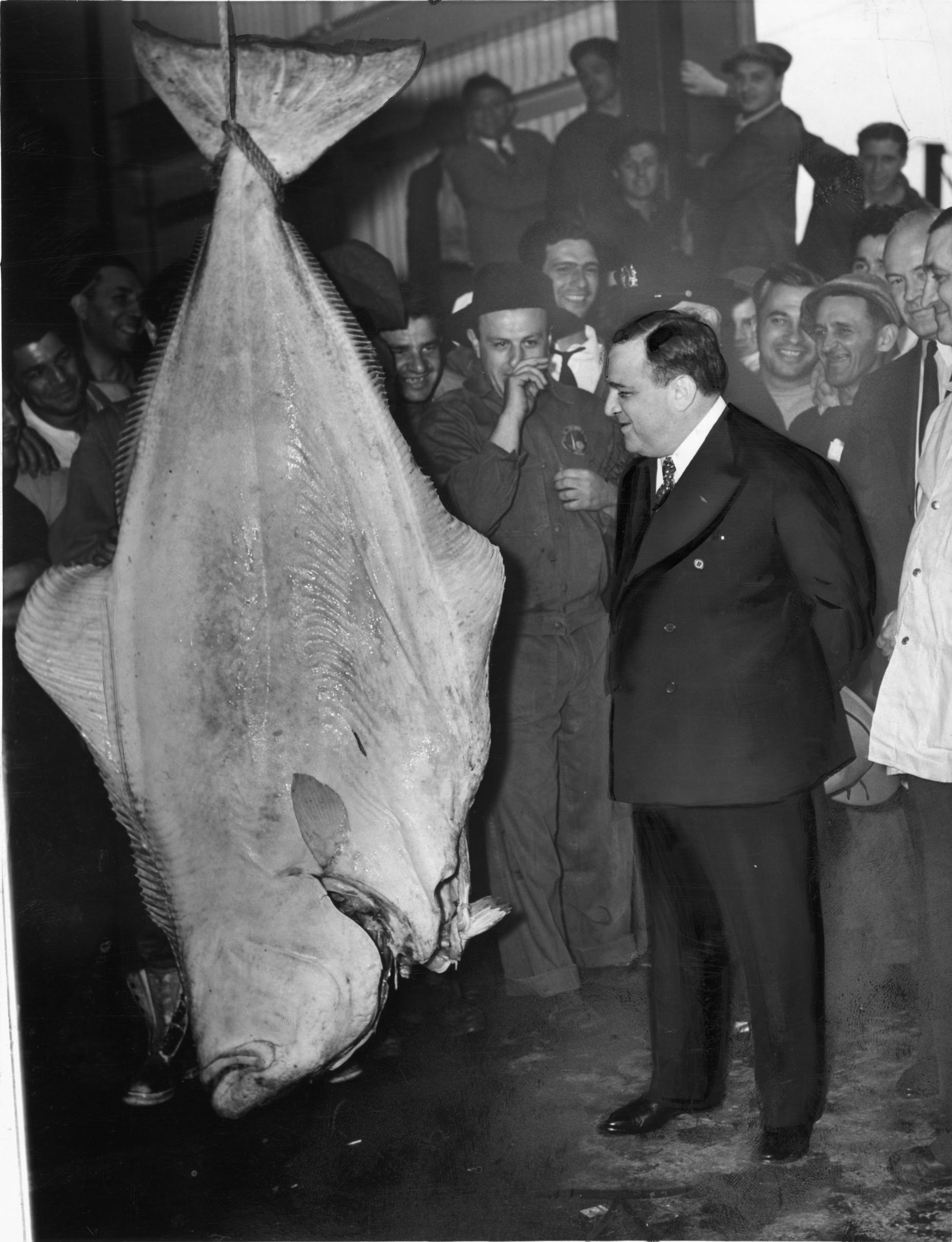Orson Welles picked up some wine money for his participation in the 1975 documentary, “Who’s Out There.” It features cool interviews with Americans who were scared to death by Welles’ famous radio hoax about an alien invasion, War of the Worlds. Welles also explores, with the help of Carl Sagan, among others, whether actual extraterrestrials exist.
You are currently browsing the yearly archive for 2011.
Tags: Carl Sagan, Orson Welles
The apartment above the Frank Lava Gunsmith shop on Centre Market Place was pretty much the perfect locale to live in if you were New York City’s leading crime photographer, as Arthur “Weegee” Fellig was from the 1930s through the 1950s. This classic 1937 photo of Weegee (photographer unidentified) shows the street-smart shutterbug during the daytime, but it was the graveyard shift when he worked and dominated. From a 2008 New York Times piece about Weegee by John Strausbaugh:
“Weegee’s peak period as a freelance crime and street photographer was a whirl of perpetual motion running from the mid-1930s into the postwar years. Ceaselessly prowling the streets during the graveyard shift, he took thousands of photographs that defined Manhattan as a film noir nightscape of hoodlums and gangsters, Bowery bums and slumming swells, tenement dwellers and victims of domestic brawls, fires and car crashes. He gave it its enduring nickname, the Naked City.
‘Weegee captured night in New York back when it was lonely and desolate and scary,’ said Tim McLoughlin, editor of the Brooklyn Noir anthology series, the third volume of which has just been published by Akashic Books. ‘He once said he wanted to show that in New York millions of people lived together in a state of total loneliness.’”
••••••••••
“You push the button and it gives you the things you want.”
Tags: Arthur Sellig, John Strausbaugh, Tim McLoughlin, Weegee
Most amusing. (Thanks Singularity Hub.)
From “Is There a Future for Airships?” a new Scientific American article wondering whether the past can become prelude:
“The notion that airships represent the future of air cargo is being revived by a new generation of entrepreneurs some 75 years after a catastrophic fireball brought the industry to a screeching halt.
Far safer than the Hindenburg, whose tragic 1937 docking remains an icon of aerospace gone wrong, these modern airships are a hybrid of lighter-than-air and fixed-wing aircraft. They can loft enormous payloads without requiring the acres of tarmac or miles of roadway necessary for conventional air and truck transport. And they do so at a fraction of the fuel and cost of aircraft.
Airships ‘give you access and much larger payloads at much lower costs,’ said Peter DeRobertis, project leader for commercial hybrid air vehicles at Lockheed Martin’s Aeronautics and Skunk Works division in Fort Worth, Texas. ‘It’s also a green aircraft; you’re not polluting.'”
••••••••••
Famously haunting summation by Herbert Morrison: “Oh, the humanity.”
Tags: Herbert Morrion, Peter DeRobertis
Millions of tons of plastic recyclables fall into our oceans from barges each year, sinking beneath the water’s surface, out of sight and out of mind. But what about plastic encroaching on nature in plain sight, why don’t we take notice of that? The always observant Ian Frazier, a proud tree hugger, does. In “Tilting at Tree Bags,” his 2001 Mother Jones article, Frazier tells of his very personal quest to relieve New York City trees of plastic bags that attached to their branches, An excerpt:
“Sometimes when we snagged an unusually pesky high bag, windows at a nearby apartment house would fly open and people would stick their heads out and applaud. Once an old woman invited us in and gave us lunch. Sometimes people came up to us and thanked us, and once a guy handed me a dollar bill. Mostly, though, people looked at us with mystication, or smiled and shook their heads in a ‘what a crazy city’ way. Once, in Brooklyn’s Prospect Park, a jogger stopped and watched us for a minute or two as we tried to remove a complicatedly entangled bag. ‘That’s a lot of trouble to go through for just a bag,’ he said. I said to him, “Is it any more pointless than running in a big circle back to your apartment?’
Bag snagging was our exercise, our companionship, our hobby, our impromptu community action program. Its aesthetic pleasures were large: A tree from which one or more plastic bags has been removed is, oddly, more beautiful than a tree which never had any bags in it to begin with. In the past, some of our outdoor activities — hitting golf balls at passing ships — had bordered on vandalism, but bag snagging gave some of vandalism’s thrill while actually being its opposite. Throughout the city we went where we wanted without asking permission, improving the landscape. Now I understood, a bit, how people felt who had worked on the construction of some major public landmark like the Empire State Building. Sometimes when I’d go by a park in a taxicab I would point out the window and say with pride, ‘You see that tree? We took an extra-large pair of green stretch pants out of it the other day.'” (Thanks Kevin Kelly.)
••••••••••
Frazier on the Colbert Report:
|
|
||||
Tags: Ian Frazier
mason jar of twin towers dust (tennessee)
While visiting the site of the twin towers collapse a little over a month after the 911 attacks I gathered a large cup of dust that was sitting on the top of a door header from a vacant building a few buildings down from the burger king. I’ve kept this dust over the years as I believed it to be a very collectible item, an historic item and a item of of great significance. If you are interested in owning this most unusual collectible please contact me at the email above. Thank you! Randall
Tags: Randall
Just a simulation–for now! (Thanks Big Think.)
A product of the Watergate decade, an era when spying and snooping at least gave us pause, Francis Ford Coppola’s The Conversation was made before ubiquitous public security cameras were watching us, phones were tracking us and seemingly everyone was living in public. A lack of privacy has never been as well-regarded as it is today nor have the perils of such actions, which are investigated in this film, been so invisible.
Harry Caul (Gene Hackman) is a jazz loving San Franciscan who earns his living as a surveillance expert, stealthily recording private conversations with an elaborate array of mikes of his own making. Caul is top dog in the trade, and he’s paid handsomely to find answers for his bosses and not ask them any questions. A devout Catholic, the wire tapper has moral issues with his work, especially since information he culled in a past case led to murder. But it’s hard for Caul to stop doing what he’s doing because he’s so damn good at it, something of an artist.
While he may be an artist, Caul is definitely a hypocrite. He keeps everything about himself strictly private, even from his girlfriend (Teri Garr) and point man (John Cazale). He rationalizes he’s doing it for safety reasons, but it’s also in his nature. This delicate balance is thrown off-kilter when Caul believes his latest assignment, in which a wealthy man is paying for info about his young wife, may also lead to murder. Caul can’t head down that road again and a crisis of conscience makes him go rogue. Soon he himself is the target of surveillance, a probing that he can’t withstand.
In the era that saw the downfall of an American President who listened to the tapes of others and erased his own, The Conversation was amazingly relevant, but in some ways it may be even more meaningful in this exhibitionist age, in which we gleefully hand over our privacy to satisfy our egos. As Caul and Nixon learned, and as we may yet, those who press PLAY don’t always get to choose when to press STOP.•
Tags: Francis Ford Coppola, Gene Hackman, John Cazale, Teri Garr
The inimitable Arkestra leader visits Egypt and Sardinia.
Tags: Sun Ra
“The Red Wheelbarrow”
so much depends
upon
a red wheel
barrow
glazed with rain
water
beside the white
chickens.
Tags: William Carlos Williams
Vital info about a California rat-killing contest couldn’t be kept from those newshounds at the Brooklyn Daily Eagle, as the June 22 edition of the paper carried a reprinted article about the topic from the Sacramento Record-Union:
“There is at present in the County Hospital a professional rat catcher, named Angel. He is a half witted, low browed fellow, and his looks indicate that he is anything but what his name would imply. As a rat catcher, however, he is a success, and late yesterday afternoon he gave an exhibition of his powers that was simply wonderful. Several of the best rat terriers in the city were procured, and against these Angel was pitted. The first exhibition of his beastly work was at the hospital, where twenty-five rodents were dispatched, Angel killing a majority.

"Angel, with the rapidity of lightning, would grasp a rat with his left hand, and with his right give the rodent's head a quick twist that would break its neck instantly."
The party then went over to the Gerber Bros. slaughter house, where the ‘game’ was found to be more plentiful. The rodents had congregated by the score under bales of hay, and the exciting contest was kept up for over an hour. The dogs and man would gather about a bale, some one would give the hay a sudden flip, and the rat catchers would rush in. Angel, with the rapidity of lightning, would grasp a rat with his left hand, and with his right give the rodent’s head a quick twist that would break its neck instantly. At other times he would grasp a rat in each hand, dash them together, and both would fall to the ground lifeless. Over 100 were killed here, and Angel killed two to the dog’s one. Prior to Angel going to the hospital, he gained a living solely by killing rats, and on one occasion slaughtered forty-five in one hour in the basement of a K street establishment.”
Tags: Angel
Biochemist Mark Roth presents a TED Talk about slowing down the biological processes of trauma victims so that they can receive life-saving treatment.
••••••••••
The other Mark Roth converts the 7-10 split, the rarest shot in bowling:
Tags: Mark Roth
From “Manson: An Oral History,” Los Angeles Magazine‘s 2009 recollection of the man behind the 1969 Tate-LaBianca murders, which rocked Hollywood and shocked a nation:
Bill Gleason, Los Angeles County deputy sheriff assigned to probe auto thefts. He is 77 and retired.
Charles Manson and some of his group just showed up at the Spahn Ranch and started living in the movie sets. Most of the buildings were false fronts, but they made them into rooms. I thought they were just a bunch of hippies, but we started getting reports that members of the Straight Satans, a motorcycle gang from Venice, were going to the ranch on weekends and partying. The word was that they were trading drugs for sex with the women there. Some of the women were runaway juveniles who provided Manson with cash and credit cards stolen from their homes. We also had reports that members of the group were shooting a machine gun. The Manson people were also stealing and building dune buggies and driving them onto adjoining properties, creating a nuisance. A couple of nights before the raid, we hiked into the ranch and found a stolen, brand-new 1969 Ford and a stolen Volkswagen. That was the main basis for our search warrant—to recover these vehicles and try to identify who stole them.
I really didn’t pay much attention to Manson. We’d already taken most of the adults out, and everyone was saying, “Where’s Charlie.” He was hiding under one of the buildings. The deputies had to go in and forcibly remove him. I arrested them one week after the Tate murders, but none of them said anything. Everybody just sat there.”
“The Family” is arrested, December 2, 1969. Lynette “Squeaky” Fromme, who is interviewed in this report. tried to assassinate President Ford in 1975.
Tags: Bill Gleason, Charles Manson, Sharon Tate
Women Police Constables began joining the ranks of the British force nearly a century ago, but they weren’t given equal status for decades.
bolders wanted (Walden)
I am looking for a way to build a fence that is indestructible. I have about 50 foot of driveway that someone is constantly abusing. I was thinking guardrail or something this next door jerk cannot destroy. If you have stone debris or something of that sort hit me up.
The Dainese D-Tec, available this year. (Thanks Reddit.)
From a 2000 Popular Mechanics article about Dainese getting involved with the design of space suits: “Dainese may be known for its luxe motorcycle helmets and leathers, but the Italian company recently displayed two pieces of decidedly futuristic apparel at the 2008 Legend of the Motorcycle Concours d’Elegance.
In anticipation of NASA’s down-the-road Mars landing missions, Dainese has teamed up with MIT for an ambitious project that intends to pressurize an astronaut’s body without the usual bubble of air that creates bulky spacesuits. We’ve seen the suit concept before, but bringing on these bike gurus is just cool—and smart.
Ditching the old-school ‘Moon Man’ image, Dainese’s futuristic space duds feature a fitted design strung with intertwining black-and-gold filaments. It may look like a sleek bodysuit by Armani, but the filaments actually serve a crucial purpose: They run along Lines of Non Extension (LoNEs) on the human body, which according to chairman Lino Dainese ‘remain stationary even when we move. If these points are united,’ he explains, ‘the same pressure is established throughout the body.’
Oddly enough, Dainese insists that this concept of ‘adherent suits’ originated in the 1950s, but was abandoned because prototypes were too stiff. While the suit has been in development for several years, Dainese hopes the suit will be used when NASA finally sets foot on the Red Planet sometime around the year 2030.”
Tags: Lino Dainese
Lost in the collateral damage of the 1973 coup d’etat in Chile that toppled Salvador Allende was Project Cybersyn, a singular computerized business control management system set up by British organizational guru Stafford Beer. “Cybersyn,” a portmanteau for Cybernetic Science, was an odd mélange of socialism, biology, business dynamics, computer science and space-age accoutrements. Telex machines in a Santiago-based control room (which seemed straight out of Star Trek) were used to sync up Chilean factories and provide real-time management for them. Its goal was no less than to regulate the entire national economy. It seems like a terrible and fascinating idea.
The control center was destroyed during the coup, but Beer’s influence went far beyond Chile or the business world; Brian Eno, an acolyte, wrote the forward to a collection of Beer essays. The following is an excerpt of Beer’s writing about Project Cybersyn at its outset:
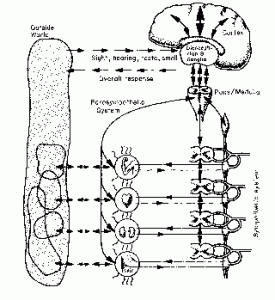 “Dear friends, I should like to greet you personally to this place, in the development of which I have taken enormous personal interest, and for this reason I am asking you to take a special interest in it. What you see is the outcome of 18 months of hard work on the part of a group of extremely professional Chilean engineers who have devoted their efforts to solving corporate management problems. They have created for us a series of tools to help us in the task of controlling the economy. Modern science, and specifically electronic computer science, offers the Government a new opportunity to address modern economic problems. We have seen that the power of this science has not yet been used in the so-called developed countries. We have developed a system on our own. What you are about to hear today is revolutionary – not only because this is the first time that this is applied in the world – it is revolutionary because we are making a deliberate effort to give the people the power that science gives to us, enabling them to use it freely.”
“Dear friends, I should like to greet you personally to this place, in the development of which I have taken enormous personal interest, and for this reason I am asking you to take a special interest in it. What you see is the outcome of 18 months of hard work on the part of a group of extremely professional Chilean engineers who have devoted their efforts to solving corporate management problems. They have created for us a series of tools to help us in the task of controlling the economy. Modern science, and specifically electronic computer science, offers the Government a new opportunity to address modern economic problems. We have seen that the power of this science has not yet been used in the so-called developed countries. We have developed a system on our own. What you are about to hear today is revolutionary – not only because this is the first time that this is applied in the world – it is revolutionary because we are making a deliberate effort to give the people the power that science gives to us, enabling them to use it freely.”
••••••••••
Beer briefly explains feedback:
Tags: Brian Eno, Salvador Allende, Stafford Beer
From the April 23, 1900 Brooklyn Daily Eagle:
“The first horseless carriage to make its appearance in Riverhead arrived here yesterday by way of Quogue. It is the property of Richard Lawrence. Mr. and Mrs. Lawrence rode out from the city on the machine and say they had a delightful trip, covering the distance to Westhampton to excellent time, with no mishaps, the first day, and coming across the plains to their home the next morning. This latter section of the trip, covering twelve miles, was made in a trifle over an hour, which is excellent time considering the sandy road. The machine is a handsome road wagon, propelled by gasoline and is known as a locomobile. It attracted a large crowd at every place it stopped at in the village and several of the staid old farm horses went into fits at its approach.”
Tags: Mrs/ Larence, Richard Lawrence
Yoga + farming + dubious adult supervision. (Thanks Reddit.)
C.M Stieglitz of the long-defunct World Telegram took this classic 1939 photograph of New York’s Mayor Fiorello LaGuardia with a 300-pound halibut. LaGuardia, a commanding presence to say the least, was famous for everything from being one of Hitler’s earliest and most outspoken critics to reading comic strips to local children on the radio. He was also known to not be allergic to cameras. LaGuardia passed away from pancreatic cancer eight years after this photo was snapped. An exceprt from his New York Times obituary:
“A city of which he was as much a part as any of its public buildings awoke to find the little firebrand dead. Its people had laughed with him and at him, they had been entertained by his antics and they had been sobered by his warnings, and they found it difficult to believe that the voice he had raised in their behalf in the legislative halls of city and nation, on street corners and over the radio, was stilled forever.
Mayor O’Dwyer, his successor, expressed this feeling. Although Mr. La Guardia’s death was expected, the Mayor said, his passing brought with it ‘a shock of awful finality.’
‘In his death the people of the city, the State and nation have lost a great, patriotic American citizen,’ the Mayor said.”
••••••••••
Tags: C.M. Stieglitz, Fiorello LaGuardia
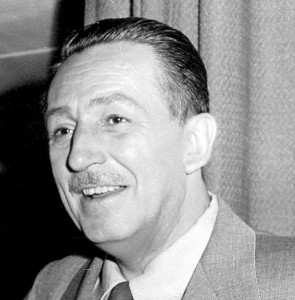
"Each year, between 7,000 and 8,000 college students and recent graduates work full-time, minimum-wage, menial internships at Disney World." (Image by NASA.)
From “Down and Out in the Magic Kingdom,” Ross Perlin’s fun inside look at the Disney World intern program, just published in Guernica:
“At Disney World, interns are everywhere. The bellboy carrying luggage up to your room, the monorail ‘pilot’ steering a train at forty miles per hour, the smiling young woman scanning tickets at the gate. They corral visitors into the line for Space Mountain, dust sugar over funnel cakes, sell mouse ears, sweep up candy wrappers. Mickey, Donald, Pluto and the gang may well be interns, boiling in their furry costumes in the Florida heat. Visiting the Magic Kingdom recently, I tried to count them, scanning for the names of colleges on the blue and white name tags that all ‘cast members’ wear. They came from public and private schools, community colleges and famous research universities, from across America. International interns, hailing from at least nineteen different countries, were also out in force. A sophomore from Shanghai greeted customers at the Emporium on Main Street, U.S.A. She was one of hundreds of Chinese interns, she told me, and she was looking forward to ‘earning her ears.’ Disney runs one of the world’s largest internship programs. Each year, between 7,000 and 8,000 college students and recent graduates work full-time, minimum-wage, menial internships at Disney World. Typical stints last four to five months, but the ‘advantage programs’ may last up to seven months.” (Thanks Longform.)
••••••••••
Mickey Mouse debuts in 1928:
The great Robert Smigel takes aim at the Mouse House:
Tags: Micey Mouse, Robert Smigel, Ross Perlin, Walt Disney
human hair 12.5″ – $600 (SoHo)
This is 12.5 inches of beautiful, thick, and full bodied virgin hair. My hair is generally considered to be dirty blonde. Some may consider it brown with natural blonde highlights.
I grew my hair out for the purpose of selling it. This means that it is completely virgin. My hair has never been blow dried, straightened, died, or chemically treated in anyway. I have never used any hair products in my hair aside from the very occasional use of shampoo and conditioner. I am also not a smoker.
My hair is wavy/curly and i am willing to shave my entire head.
I get constant compliments from woman about how unique and wonderful my hair is. Often times they will tell me that my hair is both the color and texture they have tried so hard coax out of their own hair using different treatments with no success.
I feel that my asking price is more than fair however I will take other offers into consideration.
Open Culture dug up this cool, brief clip of Vladimir Nabokov perusing covers of various editions of Lolita. Has there ever been a better written novel than Lolita? Maybe Madame Bovary? I don’t know.
Tags: Vladimir Nabokov
Several decades ago, Manhattan had a cachet the other boroughs didn’t enjoy, and bridge-and-tunnelers, as they were called, had one strike against them based on their home address. But during the 1970s, when class was a real and palpable thing in NYC, the outsiders from the outer boroughs began storming the city on Saturday nights and made it their own with the help of leisure suits and strobe lights. Nik Cohn captured the class consciousness of the city’s disco revolution in “Tribal Rites of a New Saturday Night,” an article in the June 7, 1976 issue of New York magazine, although he later acknowledged falsifying facts. At any rate, it became the basis of Saturday Night Fever, and that sensation made disco explode all over again. The opening of Cohn’s article:
“Within the closed circuits of rock & roll fashion, it is assumed that New York means Manhattan. The center is everything, all the rest irrelevant. If the other boroughs exist at all, it is merely as a camp joke—Bronx-Brooklyn-Queens, monstrous urban limbo, filled with everyone who is no one.
In reality, however, almost the reverse is true. While Manhattan remains firmly rooted in the sixties, still caught up in faction and fad and the dreary games of decadence, a whole new generation has been growing up around it, virtually unrecognized. Kids of sixteen to twenty, full of energy, urgency, hunger. All the things, in fact, that the Manhattan circuit, in its smugness, has lost.
They are not so chic, these kids. They don’t haunt press receptions or opening nights; they don’t pose as street punks in the style of Bruce Springsteen, or prate of rock & Rimbaud. Indeed, the cults of recent years seem to have passed them by entirely. They know nothing of flower power or meditation, pansexuality, or mind expansion. No waterbeds or Moroccan cushions, no hand-thrown pottery, for them. No hep jargon either, and no Pepsi revolutions. In many cases, they genuinely can’t remember who Bob Dylan was, let alone Ken Kesey or Timothy Leary. Haight Ashbury, Woodstock, Altamont—all of them draw a blank. Instead, this generation’s real roots lie further back, in the fifties, the golden age of Saturday nights.
The cause of this reversion is not hard to spot. The sixties, unlike previous decades, seemed full of teenage money. No recession, no sense of danger. The young could run free, indulge themselves in whatever treats they wished. But now there is shortage once more, just as there was in the fifties. Attrition, continual pressure. So the new generation takes few risks. It goes through high school, obedient; graduates, looks for a job, saves and plans. Endures. And once a week, on Saturday night, its one great moment of release, it explodes.” (Thanks to The Electric Typewriter.)
••••••••••
Steve Rubell tries to cash in with an album called A Night at Studio 54:
Tags: Nik Cohn, Steve Rubell

